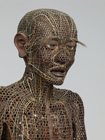Japanese Gallery (Honkan) Room 16
August 30, 2011 (Tue) - October 10, 2011 (Mon)
Staying healthy is a large concern for people today. There are many things which are bad for our health, such as lack of exercise, overeating, or stress, but it is sometimes very difficult to control ourselves. In the Edo period, Japanese read various written materials about health care. Information was available in accessible forms including waka poems, travel journals, and stories. To begin with, the Japanese word for “health care” simply meant ideas about anti-aging and increasing longevity, or philosophies about ways for humans to live. What then, was the reality of health care in the Edo period?
In a time when medical science had not developed as it has today, people primarily thought about what they should do to avoid illness. Although there were many physicians around, people generally tried to prevent disease by using things close to hand. This included keeping traditional medicinal herbs at home, drinking infusions of dokudami (chameleon plant), and burning moxa on the skin to strengthen legs.
In the following Meiji period, these ways of thinking were discarded as being unscientific, yet there is much wisdom contained in Edo-period preventive care. Through the written materials about health care on display here, we hope to find attitudes toward health in the Edo period.

